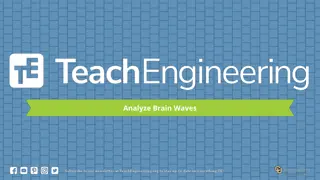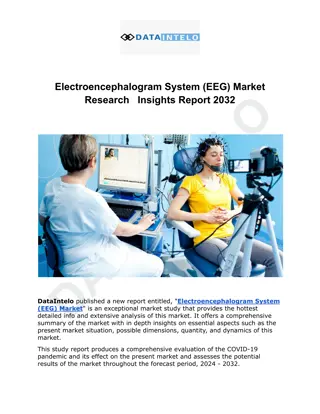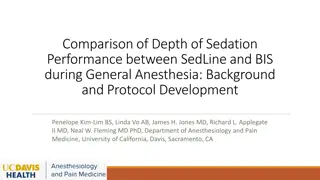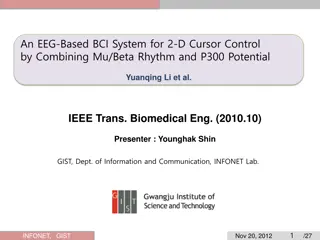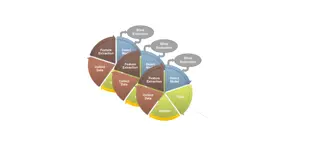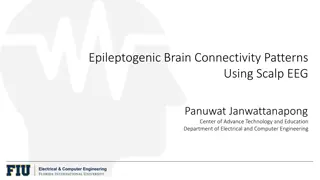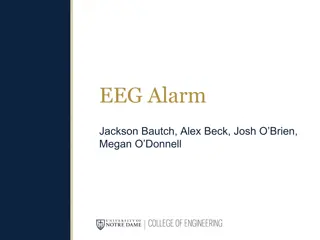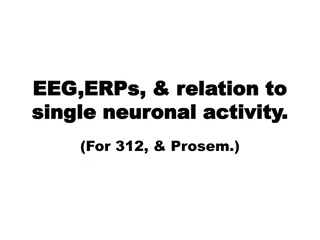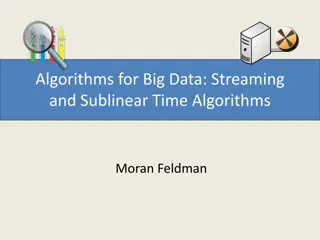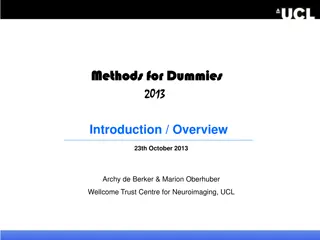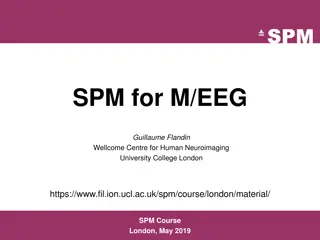SPM for M/EEG
The powerful SPM software for routine statistical analysis of functional neuroimaging data from M/EEG. Learn about its origins, advancements, and applications in a comprehensive short course.
3 views • 17 slides
Cognitive Load Classification with 2D-CNN Model in Mental Arithmetic Task
Cognitive load is crucial in assessing mental effort in tasks. This paper discusses using EEG signals and a 2D-CNN model to classify cognitive load during mental arithmetic tasks, aiming to optimize performance. EEG signals help evaluate mental workload, although they can be sensitive to noise. The
1 views • 19 slides
Basis of the M/EEG signal
This informative guide delves into the basics of M/EEG signal methods, covering topics such as the biophysical origin of M/EEG, historical background, measurement techniques, and the distinction between EEG and MEG. It explores the history of human EEG, the concept of action potentials, and the prac
1 views • 32 slides
Exercise Evaluation Training
Controllers and Evaluators play crucial roles in exercise evaluation. Controllers ensure the exercise meets objectives while maintaining safety and focus. Evaluators organize evaluation, observe, and collect data to identify strengths and areas for improvement. Exercise Evaluation Guide (EEG) provid
4 views • 14 slides
Brain Waves Through EEG Analysis
Delve into the world of brain waves with EEG, EKG, and EMG measurements. Learn how to analyze brain wave data using mathematical processes like Fast Fourier Transform (FFT) and Power Spectral Density (PSD). Discover the significance of different frequencies in brain wave signals and how they reflect
21 views • 13 slides
Electroencephalogram System (EEG) Market Research Insights Report 2032
The global electroencephalogram system (EEG) market size was USD 1.03 Billion in 2023 and is projected to reach USD 1.78 Billion by 2032, expanding at a CAGR of 6.3% during 2024\u20132032.
1 views • 5 slides
Near-Optimal Quantum Algorithms for String Problems - Summary and Insights
Near-Optimal Quantum Algorithms for String Problems by Ce Jin and Shyan Akmal presents groundbreaking research on string problem solutions using quantum algorithms. The study delves into various key topics such as Combinatorial Pattern Matching, Basic String Problems, Quantum Black-box Model, and mo
3 views • 25 slides
ACNS Critical Care EEG Terminology 2021: Part 1 of 3
This module provides an introduction to the important components of the ACNS standardized critical care EEG terminology for 2021. It discusses common terms and components of EEG background, sporadic epileptiform discharges, rhythmic and periodic patterns (RPPs), electrographic and electroclinical se
3 views • 41 slides
Combining Graph Algorithms with Data Structures and Algorithms in CSE 373 by Kasey Champion
In this lecture, Kasey Champion covers a wide range of topics including graph algorithms, data structures, coding projects, and important midterm topics for CSE 373. The lecture emphasizes understanding ADTs, data structures, asymptotic analysis, sorting algorithms, memory management, P vs. NP, heap
4 views • 38 slides
Comparison of SedLine and BIS Depth of Sedation Performance in General Anesthesia
This study evaluates the performance of SedLine and BIS monitoring devices in measuring anesthetic depth during general anesthesia. The research protocol aims to compare processed EEG indices from both monitors across various levels of anesthetic depth using a custom interface box. Inclusion criteri
2 views • 10 slides
EEG Conformer: Convolutional Transformer for EEG Decoding and Visualization
This study introduces the EEG Conformer, a Convolutional Transformer model designed for EEG decoding and visualization. The research presents a cutting-edge approach in neural systems and rehabilitation engineering, offering advancements in EEG analysis techniques. By combining convolutional neural
1 views • 6 slides
Randomized Algorithms: A Deep Dive into Las Vegas and Monte Carlo Algorithms
Randomized algorithms incorporate randomness into computations, with Las Vegas algorithms always providing the correct answer but varying in time, while Monte Carlo algorithms occasionally give wrong answers. Quick Sort is a classic Las Vegas algorithm that involves pivoting elements for sorting. Ch
7 views • 21 slides
Mathematical Analysis of Algorithms in CMPE371 - Fall 2023-2024
Explore the mathematical analysis of algorithms in CMPE371 for Fall 2023-2024, focusing on non-recursive and recursive algorithms. Learn how to analyze non-recursive algorithms by deciding on input size parameters, identifying basic operations, and simplifying summations. Dive into recursive algorit
3 views • 31 slides
EEG-Based BCI System for 2-D Cursor Control Combining Mu/Beta Rhythm and P300 Potential
Brain-computer interfaces (BCIs) offer a pathway to translate brain activities into computer control signals. This paper presents a novel approach for 2-D cursor control using EEG signals, combining the Mu/Beta rhythm and P300 potential. By simultaneously detecting two brain signals, P300 and motor
2 views • 27 slides
Advanced Applications of GLM and SPM in M/EEG Course 2018
This course delves into utilizing Convolution GLM to address challenges such as baseline correction, overlapping neural responses, and systematic response timing differences in EEG experiments. It focuses on the stop-signal task, EEG correlates of movement stopping, and MEG data analysis. The course
0 views • 26 slides
Exploring the Role of Algorithms in Game Design
Delve into the world of algorithms in game design, from understanding the fundamental concept of algorithms to their pervasive presence in various aspects of gaming, such as military simulations, medical simulations, and gameplay mechanics. Explore how algorithms shape experiences in different types
24 views • 10 slides
Analysis of Deep Learning Models for EEG Data Processing
This content delves into the application of deep learning models, such as Sequential Modeler, Feature Extraction, and Discriminator, for processing EEG data from the TUH EEG Corpus. The architecture involves various layers like Convolution, Max Pooling, ReLU activation, and Dropout. It explores temp
3 views • 15 slides
Multichannel EEG Compression Using COMPROMISE Study
A study on multichannel EEG compression using COMPROMISE by Duc Thien Pham, Josef Kohout, Ivana Kolingerova, Pavel Nejdar from the Department of Computer Science and Engineering, Faculty of Applied Sciences, University of West Bohemia. The study covers datasets, methods, and discussions related to E
4 views • 12 slides
Uncovering Epileptogenic Brain Connectivity Patterns Through Scalp EEG
Epilepsy is a common neurological disorder characterized by unprovoked seizures, affecting a significant portion of the population. Enhancing the diagnosis and prediction of seizures through EEG recordings can improve therapeutic strategies for epilepsy patients. Functional connectivity analysis in
2 views • 21 slides
Innovative Sleep Monitoring Device for Improved Rest
EEG Alarm by Jackson Bautch, Alex Beck, Josh O'Brien, and Megan O'Donnell offers a solution to track sleep stages throughout the night using Electroencephalogram (EEG) technology. With fewer electrodes and a compact design, the device sends sleep data to the user's phone and sets off an alarm during
2 views • 7 slides
The Relationship between EEG, ERPs, and Single Neuronal Activity
This detailed information discusses the relationship between EEG, ERPs, and single neuronal activity, exploring how electrodes record signals based on tip diameter and biological amplifier filter settings. It delves into parameters that determine what an electrode records, highlighting the importanc
4 views • 56 slides
Video-EEG Monitoring in Neurology
Detailed information on the uses, options, and activation procedures for Video-EEG monitoring in neurology, focusing on diagnosis, interictal epileptiform discharges, medication adjustment, and surgical candidacy evaluation. Learn about the yield of EEG monitoring, methods to increase yield, and dif
1 views • 43 slides
EEG Evaluation for 9-Year-Old Female Patient
EEG slides of a 9-year-old female patient in an awake state with eyes closed and no medication reveal various segments in monopolar and bipolar montages. The EEG changes are compared between different montages, including segments with notable alterations. Changes in brain activity are observed durin
56 views • 36 slides
Mind-Controlled Robot Research and Applications
EEG technology allows for mind-controlled robots, aiding in various applications including neuroscience research, medical assistance, and human-computer interfacing. Advancements in EEG devices like Neurosky Mindwave have made brain-computer interaction accessible and innovative, paving the way for
4 views • 4 slides
EEG study of semantic and syntactic
This study by Marc M. Van Hulle explores the effects of semantic and syntactic violations in music on brain activity using EEG. The experiment involves dual priming with stimuli including Mozart and Brahms melodies. Preliminary results suggest that incongruencies between text labels and music tracks
0 views • 14 slides
Algorithms for Big Data: Streaming and Sublinear Time Algorithms
Motivation behind big data research, exploration of sublinear time algorithms, and analysis of algorithms for diameter approximation and property testing. The talk delves into theoretical algorithms for big data problems, focusing on streaming and sublinear time algorithms, showcasing classical exam
4 views • 30 slides
Hyperdimensional Computing for EEG Error-Related Potentials
This study explores Hyperdimensional Computing for noninvasive Brain-Computer Interfaces, specifically focusing on blind and one-shot classification of EEG Error-Related Potentials. The research delves into the architecture, basics, and experimental results of applying Hyperdimensional Computing to
3 views • 19 slides
Electroencephalogram
The Electroencephalogram (EEG) is a medical test used to measure the electrical activity of the brain. Electrodes are attached to the scalp to record brain waves, providing valuable information for diagnosing seizure disorders, epilepsy, coma, and more. Learn about the purpose, procedure, and nursin
1 views • 20 slides
Brain Research Methods: Understanding Changes in Brain Function
Studies in brain research methods focus on examining changes in behavior, personality, and sensory capacity caused by brain diseases or injury. Techniques such as ablation, electrical stimulation, deep lesioning, ESB, microelectrodes, and EEG are used to investigate brain functions and responses. Ab
3 views • 12 slides
The Bioelectric Potentials(contd.)
This content delves into EEG brain wave classification, patterns, and applications in monitoring brain activity, identifying damage, testing cognitive engagement, and investigating neurological disorders like epilepsy. EEG offers fast recording of neural activity and complements MRI for better brain
1 views • 17 slides
EEG Evidence for Phonological Velar Softening
This study investigates the phonological phenomenon of velar softening using EEG data, supporting the truly phonological nature of the process. Six EEG experiments were conducted with 23 participants, focusing on inflectional plural formation and velar softening in English. The results suggest a pho
2 views • 24 slides
Human Brain Imaging Analysis Methods: A Comprehensive Overview
Explore the introductory insights into human brain imaging analysis methods, specifically focusing on fMRI and M/EEG. The program aims to cover basic statistics, fMRI (BOLD), EEG/MEG, connectivity, VBM, DTI, and more using SPM12. Join us for an in-depth exploration every Wednesday at FIL Seminar Roo
0 views • 76 slides
Advanced Techniques in M/EEG Analysis and SPM Software Overview
Explore advanced techniques in M/EEG analysis, including Random Field Theory, Statistical Parametric Mapping, Source Analysis, Dynamic Causal Modelling, and the evolution of SPM software by Karl Friston. Learn about the applications of these methods in neuroimaging research and access free and open-
3 views • 14 slides
Neocortical Interactions and EEG Influence Study
Delve into the intricate relationships between electroencephalographic (EEG) patterns and Ca2+ waves in the brain, exploring scales of neocortical interactions, synaptic mechanisms, and statistical mechanics. This study by Lester Ingber provides insights into the molecular and quantum scales of neur
1 views • 39 slides
10-20 System Positioning for EEG Measurements
Learn how to accurately position electrodes using the 10-20 system for EEG measurements. Follow step-by-step instructions to mark key points such as Cz, Fpz, Oz, Fz, Pz, T3, and T4, ensuring precise and reliable readings. Utilize diagrams for visual guidance throughout the process.
0 views • 25 slides
Temple University EEG Data Management Project
Temple University's College of Engineering and Temple University Hospital System have collaborated on the Clinical EEG Database Project, led by Sung In Choi. The project involves processing EEG data, analyzing the data files, and transferring them using specific steps outlined in the protocol. The a
2 views • 8 slides
Neurocritical Monitoring Techniques: PIC and EEG Insights
Discover the critical methods of monitoring neurological patients globally, with a focus on intracranial pressure (PIC) measurements and electroencephalography (EEG) in this insightful content. Explore historical observations, modern practices, and considerations for optimal neuroprotection. Dive in
0 views • 14 slides
Innovative EEG Signal Analysis Project Overview
Explore Pedro Henrique da Rocha Garrit's weekly presentation on utilizing EDFbrowser and MATLAB for EEG signal montages and analysis. Discover the accomplishments, including creating a montage file and MATLAB program, as well as future plans for wavelet-based feature extraction in EEG signal process
0 views • 4 slides
Wavelet-Based EEG Signal Feature Extraction: Pedro Henrique da Rocha Garrit Presentation
Pedro Henrique da Rocha Garrit presents his weekly achievements in implementing a wavelet-based feature extraction algorithm for EEG signals, inspired by a research paper on heart rate variability analysis. He successfully executed the algorithm in MatLab, generating output as text files. His future
0 views • 4 slides
EEG Data Management and Reorganization
Explore the status of EEG data, reports, and the process of reorganizing information. Learn about defective CDs, online data, new tools for converting data, and the format of EEG reports. Dive into the challenges faced in report formats and impedance reports, with a focus on reorganizing HDD space a
0 views • 11 slides




